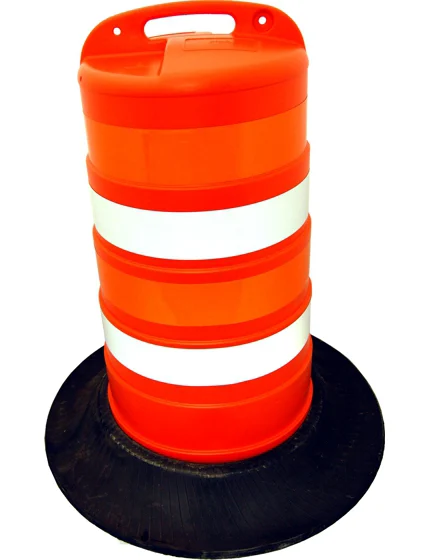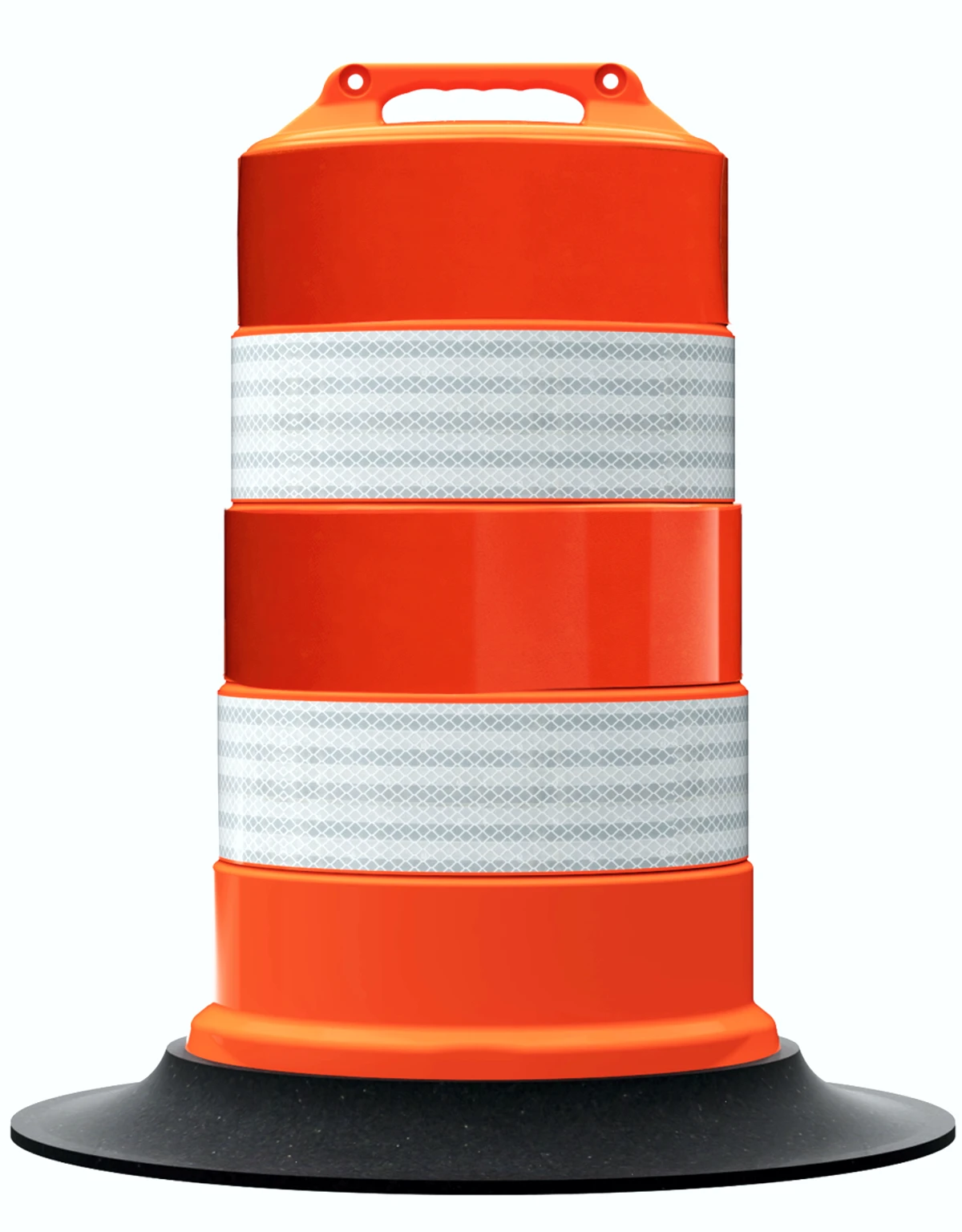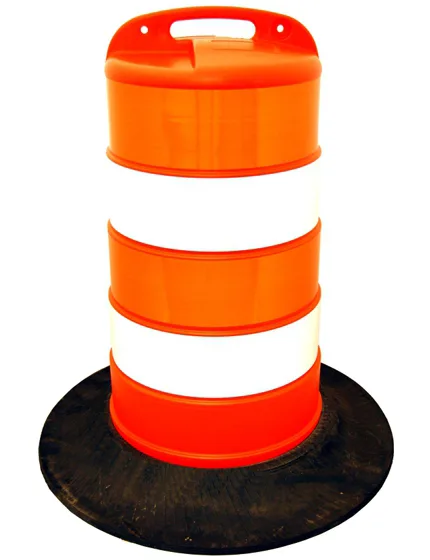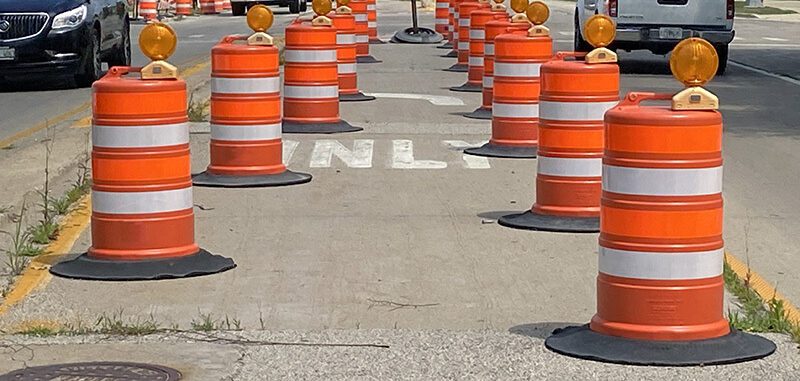The History and Evolution of Traffic Drums (Traffic Barrels)
Traffic drums – also referred to as traffic barrels – are familiar fixtures in highway work zones. Often made of bright orange plastic with reflective white stripes, these channelizing devices help direct vehicles around construction areas and hazards. According to the Manual on Uniform Traffic Control Devices (MUTCD), traffic drums are highly visible, command respect from drivers, and serve a critical safety function by alerting motorists to changing road conditions.Overview of Traffic Drums
Standing about waist-high or taller, modern traffic drums are hard to miss, thanks to their bright orange color and large, retroreflective stripes. Most models also feature a built-in handle on top, allowing easy relocation and also creating a spot for the attachment of flashing warning lights for night use. Their size and robust appearance force drivers to pay attention – a vital element in work zone safety.
Early Origins: From Simple Barrels to Purpose-Built Drums
Before purpose-built traffic drums existed, road crews marked work zones using wooden sawhorses, lanterns, and (later) traffic cones. While these earlier markers offered some visibility, they also had significant drawbacks: cones blew over easily, lanterns weren’t always bright enough, and wooden barriers were cumbersome. A major innovation arrived in 1970 when Charles D. Scanlon – already known for inventing the rubber traffic cone in the 1940s – unveiled the first dedicated traffic barrel. Early versions frequently involved repurposing steel drums painted in orange and white stripes. Although these steel barrels improved visibility and could be weighted for stability, they introduced new hazards. Filled drums were extremely heavy and could cause severe damage if struck by a vehicle. Over time, rust and dents also reduced their effectiveness and visibility.Evolution in Design: From Steel to Plastic
By the late 1970s and early 1980s, manufacturers began experimenting with lightweight plastic barrels. Plastic could flex on impact, reducing damage to vehicles, and was far less prone to weather-related wear. The first plastic designs were two-piece units often stabilized with sandbags. These prototypes proved far easier to transport and set up than their steel counterparts. In the early 1990s, plastic traffic drums quickly replaced steel barrels across the United States. The 3rd Revision of the 1988 MUTCD (published in 1993) even banned metal traffic drums altogether. Innovations continued, such as incorporating a rubber tire base (often made from recycled tires) to keep the barrel from tipping in high winds without requiring heavy sand or water as ballast. Modern examples showcased robust polyethylene construction, top handles for easy moving, and low-center-of-gravity designs that resist tipping. Today’s plastic barrels are typically made of UV-resistant polyethylene and can be stacked for efficient transport. Many include molded-in hardware or handles so that flashing warning lights can be attached on top for nighttime visibility.Role in Modern Road Safety
Traffic barrels (drums) are now a mainstay in virtually every U.S. highway work zone. They help:- Channel vehicles away from construction areas or active lanes.
- Provide visual cues that prompt drivers to slow down, especially in high-speed zones.
- Create modular barriers that can be set up quickly and rearranged as needed.
Best Practices for Using Traffic Drums
To ensure effective deployment of traffic drums, agencies and contractors often follow guidelines set forth by the MUTCD, which include:- Proper Spacing: Drums should be placed close enough so that drivers cannot easily stray between them, yet far enough to guide traffic smoothly.
- Secure Ballast: Use only approved ballasting methods (e.g., weighted bases).
- Consistent Reflectivity: All drums in a work zone ideally should have matching or compatible reflective properties to ensure uniform visibility.
- Regular Inspection: Periodically check drums for damage, dirt, or faded reflectivity, replacing units as needed to maintain safety.
Reflective Sheeting Levels and Standards
One of the most important features of traffic drums is their retroreflective striping. The Federal Highway Administration (FHWA) requires that any channelizing device used at night be clearly visible to motorists. Common types of reflective sheeting include:- Engineer Grade Drums (Type I): Basic enclosed-bead sheeting with limited nighttime brightness. Suitable for low-speed areas or daytime-only projects.
- High-Intensity Prismatic Drums (Type III/IV): Mid-range reflective sheeting that is 2–3 times brighter than Engineer Grade, visible up to 1,000 feet under headlights, making it ideal for most highway applications.
- Diamond Grade Drums (Type VI, VIII, or IX): Premium microprismatic sheeting capable of being 10× brighter than Engineer Grade. Often used in high-speed or long-term projects where maximum visibility is needed.
Where to Buy High-Quality Traffic Drums
When choosing traffic drums for highway or construction projects, it’s crucial to look for products that meet MUTCD specifications and have undergone official crash testing, such as NCHRP 350 or MASH approvals. TrafficSafetyStore.com offers a wide selection of MUTCD-compliant, durable traffic barrels with various reflective sheeting options to meet different project requirements. Ensuring you select the right grade of reflectivity and base weight can significantly improve safety and reduce liability in work zones.Summary
From their humble beginnings as painted steel drums to today’s lightweight, impact-resistant plastic designs, traffic drums have revolutionized work zone safety. Their visibility, ease of deployment, and ability to guide drivers effectively make them an essential tool for any construction or maintenance operation. As innovations in design and materials continue, traffic drums will remain a cornerstone of road safety measures, helping reduce accidents and protect both motorists and workers.Additional Resources & References
- Manual on Uniform Traffic Control Devices (MUTCD)
- Federal Highway Administration (FHWA)
- TrafficSafetyStore.com – Traffic Barrels
- NCHRP 350 / MASH guidelines on crashworthiness of roadside safety devices
Disclaimer: This article is for general informational purposes only. Please understand and follow local laws and specific state regulations

Plastic Channelizer Drum with Tire Base
At 37-inches tall with a 23-inch diameter base, our plastic drum channelizer barrier exceeds standard safety dimensions. Known also as highway barrels, road drums, channelizer drums, highway drums, or traffic drums, these are made from lightweight polyethylene while the hefty base is composed of recycled tires so no additional ballast is needed. Even if it does tip over, it's unique shape inhibits it from rolling into traffic. Ideal for freeways, interstates and other high speed roadways.
Bold, UV-resistant orange with orange and white reflective stripes – 4-inch or 6-inch on engineer grade, high-intensity and diamond grade sheeting. Separate type A or C barricade “flasher” lights can be mounted to the handle for added visibility. Tapered for easy stacking. Ships immediately.
Exceeds Safety Standards: MUTCD; NCHRP crash test rating of 350
Quick Facts:

Plastic Drum with 6" DG Stripes & Base
Plastic Drum with 6" DG Stripes & Base
Quick Facts:
-
Durable and Stable Design: The Plasticade Commander™ Traffic Drum features advanced materials for durability and a unique tire locking ring for secure placement in various conditions.
-
Customizable and Compliant: Fully MASH Accepted and MUTCD-compliant, with options for custom branding.
-
Space-Saving Efficiency: Foldable light mount and stackable design make it easy to transport and store, ideal for large-scale traffic management projects.

Plastic Channelizer Drum with Tire Base
At 37-inches tall with a 23-inch diameter base, our plastic drum channelizer barrier exceeds standard safety dimensions. Known also as highway barrels, road drums, channelizer drums, highway drums, or traffic drums, these are made from lightweight polyethylene while the hefty base is composed of recycled tires so no additional ballast is needed. Even if it does tip over, it's unique shape inhibits it from rolling into traffic. Ideal for freeways, interstates and other high speed roadways.
Bold, UV-resistant orange with orange and white reflective stripes – 4-inch or 6-inch on engineer grade, high-intensity and diamond grade sheeting. Separate type A or C barricade “flasher” lights can be mounted to the handle for added visibility. Tapered for easy stacking. Ships immediately.
Exceeds Safety Standards: MUTCD; NCHRP crash test rating of 350
Quick Facts:

